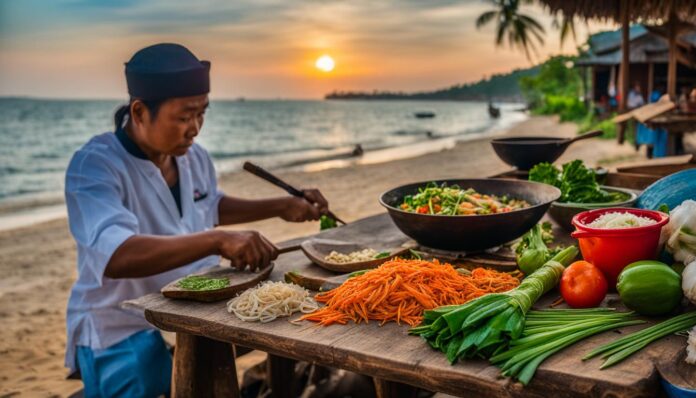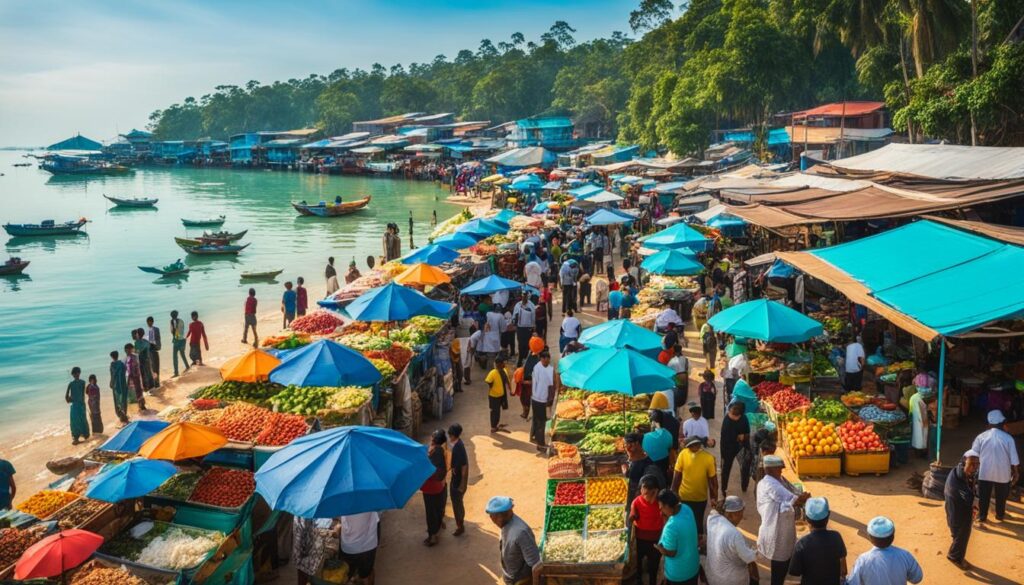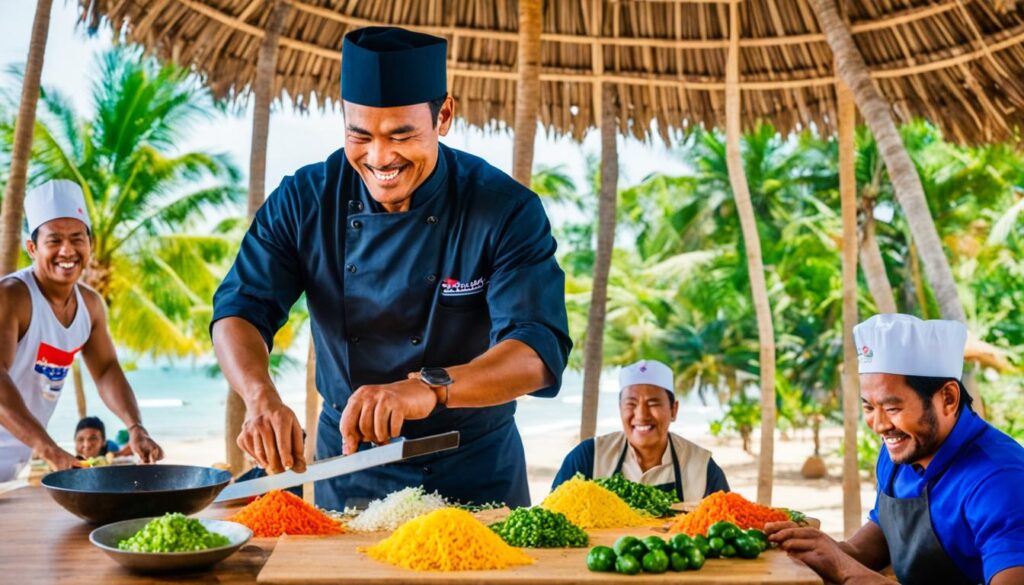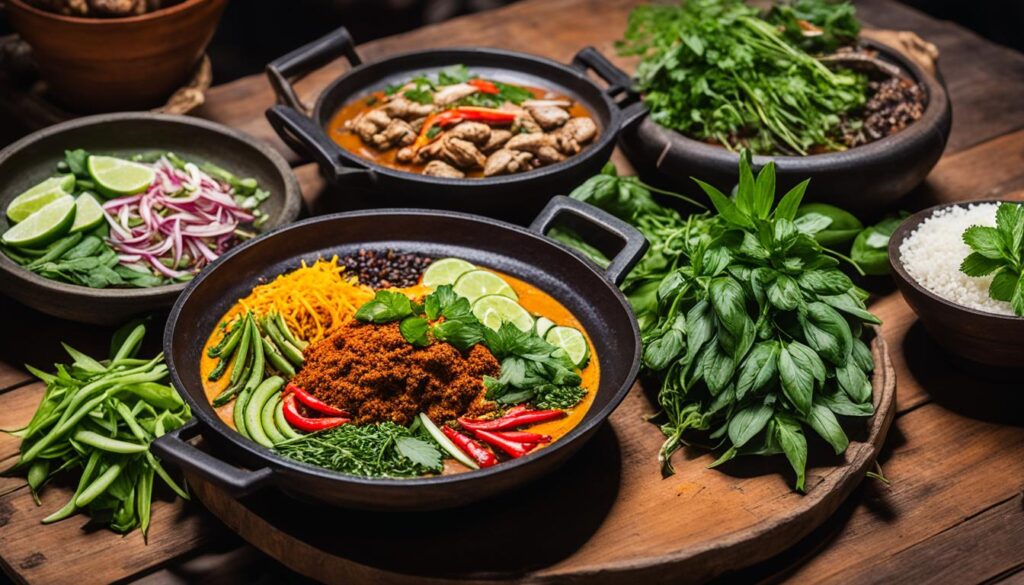If you’re interested in learning Khmer cooking basics and preparing local dishes in Sihanoukville, you’ve come to the right place. We have put together a comprehensive guide that will take you on a culinary journey like no other. Through Khmer cooking classes and exploring Sihanoukville’s food culture, you’ll discover the unique flavors and techniques that make Cambodian cuisine so special.
Sihanoukville, Cambodia is known for its famous beaches and tropical climate, but its food culture is equally impressive. By enrolling in Khmer cooking classes taught by experienced local chefs, you will learn how to make traditional Khmer dishes using local ingredients and cooking techniques. Whether you’re a beginner or a seasoned cook, our guide is designed to equip you with the knowledge and skills needed to master Khmer cooking in Sihanoukville.
Embrace Cambodian Cuisine: Understanding the Basics
To fully appreciate Khmer cooking, it’s essential to have an understanding of Cambodian cuisine. It’s characterized by the use of fresh ingredients, aromatic herbs and spices, and a balance of sweet, sour, spicy, and salty flavors. The cuisine is renowned for its unique combination of ingredients and cooking techniques, which create the authentic Khmer dishes you’ll learn to prepare.
Authentic Khmer dishes are usually made from local ingredients and are prepared using unique Khmer cooking techniques. Some examples of traditional Khmer dishes you’ll learn to prepare include:
- Amok – a delicious, fragrant fish curry, wrapped in banana leaves
- Lok Lak – a popular beef stir-fry dish served with rice and a tangy dipping sauce
- Somlah Machou Khmae – a sour soup made with fish and a range of vegetables
The use of specific ingredients and cooking techniques distinguishes Cambodian cuisine from other Southeast Asian cuisines. For example, bok choy is a common ingredient in many Chinese dishes, but it’s rarely used in Khmer cuisine. Instead, Cambodian dishes make use of locally grown ingredients such as lotus stem, lemongrass, and turmeric.
The balance of flavors is also a key feature of Khmer dishes. A typical Khmer meal will include sweet, sour, spicy, and salty flavors, all in harmony with one another. Achieving this balance requires an understanding of how each ingredient contributes to the overall flavor of the dish.
“Cambodian cuisine is a treasure trove of unique flavors and cooking techniques. It’s a cuisine that’s been influenced by centuries of history and cultural exchange, creating a unique blend of ingredients and flavors that you won’t find anywhere else.”
Exploring Sihanoukville’s Food Culture
Indulge in the vibrant food culture of Sihanoukville, a coastal city rich in Khmer cuisine. To fully immerse yourself in this culinary journey, explore the bustling local markets and engage with the friendly vendors who are always happy to share their knowledge.
- Discover the local ingredients that play a fundamental role in Khmer cooking
- Souce fresh seafood from the nearby ocean
- Learn about the significance of certain ingredients and spices in Cambodian cuisine
Take a stroll through the streets and alleyways of Sihanoukville to observe the hustle and bustle of daily life. The scents of grilling meats, simmering curries, and steaming rice wafting from food carts will entice your senses and awaken your taste buds.
As you explore the city, make sure to stop by popular restaurants and food stalls to sample the delicious local fare. From savory soups to spicy stir-fries, there is something to please every palate.
“Sihanoukville’s food culture is a reflection of the city’s history, geography, and people. It is a unique blend of Khmer, Chinese, and French influences that has evolved over time. To truly appreciate this cuisine, you need to understand the stories behind each dish and the significance of the ingredients used.”
The food culture of Sihanoukville is a feast for the senses and an essential part of the Khmer culinary experience. Embark on this culinary journey and discover the hidden gems of this coastal city.
Join Khmer Cooking Classes in Sihanoukville
If you want to immerse yourself in the local culture and learn how to prepare authentic Khmer dishes, enrolling in Khmer cooking classes in Sihanoukville is a must. Led by experienced local chefs, these classes provide hands-on experience that takes you through the step-by-step process of creating traditional Khmer recipes. Throughout the classes, you’ll gain insights into the cultural significance of each dish and the historical influences that have shaped Cambodian cuisine.
From mastering the art of slicing and dicing to understanding the precise tempering of spices, these classes focus on developing the essential skills needed to recreate authentic Khmer flavors in your own kitchen. Whether you’re a beginner or an experienced cook, you’re sure to learn something new.
Khmer cooking classes in Sihanoukville are an opportunity to get hands-on experience in the local culinary traditions. Sign up now and embark on a journey of discovery through Khmer cuisine.
What you’ll learn in Khmer Cooking Classes
During your Khmer cooking classes in Sihanoukville, you’ll learn new skills and techniques aimed at reproducing the rich, authentic flavors of Khmer cuisine.
| Skills and Techniques | What you’ll learn |
|---|---|
| Slicing and dicing | Master the art of cutting up vegetables, fruits, and proteins with ease to achieve perfect-sized pieces. |
| Tempering spices | Understand how to balance the flavors of your dish using precise amounts and right combinations of herbs and spices. |
| Marinating | Learn how to prepare marinades with an aromatic blend of herbs and spices to enhance the flavor of your meats and proteins. |
| Cooking techniques | Discover the cooking techniques responsible for creating the unique textures and flavors of Khmer dishes, including stir-frying, simmering, and steaming. |
After completing your Khmer cooking classes in Sihanoukville, you’ll have the confidence and skills to prepare traditional Cambodian dishes in your own kitchen. Whether you’re eager to impress guests at your next dinner party or simply want to enjoy the rich flavors of Khmer cuisine on your own, these classes are an investment in your culinary future.
Mastering Khmer Cooking Techniques
Now that you have a solid understanding of Cambodian cuisine and explored Sihanoukville’s food culture, it’s time to delve deeper into the intricacies of Khmer cooking techniques. By mastering these techniques, you’ll be able to create flavorful dishes that perfectly balance sweet, sour, spicy, and salty tastes, characteristic of Khmer cuisine.
Let’s start with creating curry pastes. Khmer curries are known for their complex, flavorful pastes made from a variety of herbs and spices. Use a mortar and pestle to pound all the ingredients into a smooth paste, controlling the consistency by adding oil. Practice makes perfect, so adjust the amount of each ingredient to your liking.
Marinating meats with aromatic spices is another critical technique in Khmer cooking. Marinades help to tenderize meat and infuse it with flavor. Khmer marinades often contain a mix of lemongrass, garlic, shallots, and other herbs and spices that pack a punch of flavor. Remember to let the meat sit in the marinade for at least an hour to allow it to be well seasoned.
The art of stir-frying is essential in Khmer cuisine. Stir-frying briefly and succinctly at high heat ensures that all the veggies retain their crispness and the meat remains juicy and tender. Use a natural oil with high smoking point and heat your wok or pan first to avoid a mushy result.
The key to mastering Khmer cooking techniques is finding balance. Balancing the sweet and sour in the famous Khmer soups called “samlor” is a perfect example. Locals follow the rule of using 5 flavors in each dish: sweet, sour, spicy, salty, and, occasionally, bitter. The ingredients in Khmer dishes are used to intensify their flavors, and that intensification is based on experience. You, too, can learn this technique with practice.
Practice makes you a master. So, keep experimenting with local ingredients and enhance your skills. The more you learn, the more you can infuse your dishes with the essence of Cambodian flavors. Up next, we will discover cooking with local ingredients that are integral to Khmer cooking.
Cooking with Local Ingredients
One of the key elements that define Khmer cuisine is the use of fresh, local ingredients. To truly master the art of Khmer cooking, it’s essential to get to know the ingredients that are integral to this cuisine. From fragrant lemongrass and galangal to delicate fish sauce and palm sugar, each ingredient contributes to the depth and complexity of Khmer dishes.
Learning how to identify, select, and prepare these ingredients is crucial to creating authentic Khmer flavors. It’s also important to understand the seasonality of certain ingredients and how their flavors evolve throughout the year.
Common Local Ingredients in Khmer Cooking
| Ingredient | Flavor Profile | Commonly Used In |
|---|---|---|
| Lemongrass | Citrusy, herbal | Curries, soups, stir-fries |
| Galangal | Spicy, earthy | Curries, soups, marinades |
| Kaffir Lime Leaves | Aromatic, citrusy | Curries, soups, salads |
| Fish Sauce | Salty, umami | Dipping sauces, marinades |
| Palm Sugar | Sweet, caramel-like | Desserts, marinades |
By using local ingredients in your cooking, you will not only experience the authentic flavors of Khmer cuisine but also support local farmers and vendors. Try incorporating a variety of these ingredients into your dishes and experiment with different flavor combinations to elevate your cooking to new heights.
Unlocking Traditional Khmer Recipes
Discover a range of delicious traditional Khmer dishes that you can easily recreate at home. These recipes exhibit the diverse flavors and techniques of Cambodian cuisine, allowing you to experience the authenticity of Khmer cooking.
1. Fish Amok
A signature Khmer dish, Fish Amok is a fragrant curry made with local fish and coconut milk, steamed in banana leaves. The dish balances the flavors of lemongrass, kaffir lime, and galangal, creating a delectable creamy texture. Savor the taste sensation of Cambodia in your own home!
2. Mango Salad
Enjoy the refreshing flavors of Cambodia with this Mango Salad recipe. The combination of ripe mangoes, fresh herbs, and sweet and sour dressing provides a mouthwatering taste of Khmer cuisine.
“The perfect balance of sweet and sour – truly amazing!” – Local Chef
3. Beef Lok Lak
This beef dish is prepared with traditional Khmer flavors, and its name derives from the sound of the meat being tossed in the wok. The meat is marinated with garlic, sugar, and fish sauce, and served with a tangy lime and black pepper dipping sauce, making for an unforgettable taste experience.
- Pro tip: Slice the meat finely against the grain for ultimate tenderness.
4. Char Kroeung Sach Ko
A classic Khmer stir-fry, Char Kroeung Sach Ko blends various meats with a distinct Cambodian spice paste. Make this with beef or chicken, and relish the flavors of the local spices, such as turmeric, lemongrass, and garlic, infused into the dish. Perfect for a quick and easy dinner!
5. Kuy Teav
A Khmer breakfast dish, Kuy Teav is satisfying and energizing. It is made with thin rice noodles, sliced pork, sometimes seafood, and a range of herbs, including green onions, fried garlic, and cilantro. This dish is light to eat but filling and comforting. The perfect start to any day!
Recreate these Khmer recipes at home, and your taste buds will take you on a flavorful journey through Cambodia’s rich culinary heritage.
Tasting the Fruits of Your Labor
Now that you have mastered the art of Khmer cooking, it’s time to indulge in a Khmer culinary experience. Sit down with your loved ones and take pleasure in the delightful flavors and textures that embody Cambodian cuisine. Revel in the sense of accomplishment that comes with recreating authentic Khmer dishes using local ingredients and Khmer cooking techniques.
Share your culinary creations and impress your friends and family with your newfound skills and knowledge of Khmer cooking. As you savor each bite, reflect on the vibrant food culture of Sihanoukville and the unique characteristics that make Cambodian cuisine so special.
Through your Khmer cooking classes and hands-on experience with local ingredients, you have gained a deeper understanding and appreciation of the rich history and cultural significance of Cambodian cuisine. Take pride in your ability to recreate authentic Khmer flavors and continue to explore the vast world of Khmer cooking.
Conclusion
Congratulations on completing your journey to master Khmer cooking in Sihanoukville! You have gained a solid understanding of Cambodian cuisine and learned how to prepare authentic local dishes using traditional Khmer cooking techniques and local ingredients.
Enrolling in Khmer cooking classes was the first step towards embracing Cambodian cuisine and exploring the vibrant food culture of Sihanoukville. By immersing yourself in the sights, sounds, and flavors of this coastal city, you have gained insights into the rich history and cultural significance of Khmer cuisine.
Unlocking the secrets of traditional Khmer recipes allowed you to experiment with flavors, textures, and ingredients, and adapt them to your personal taste preferences. Sharpening your Khmer cooking skills has equipped you to continue exploring the vast world of Cambodian cuisine and bring the vibrant flavors of Cambodia into your own kitchen.
Thank you for joining us on this culinary journey, and we hope you continue to embrace new cultures through their food.

















































